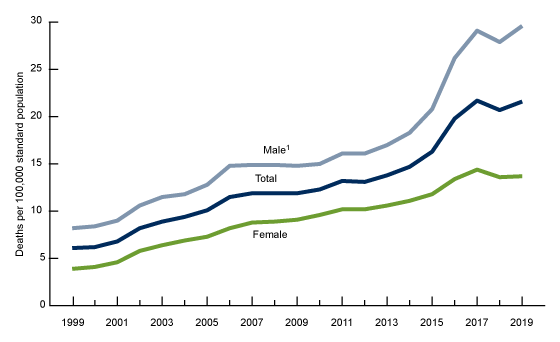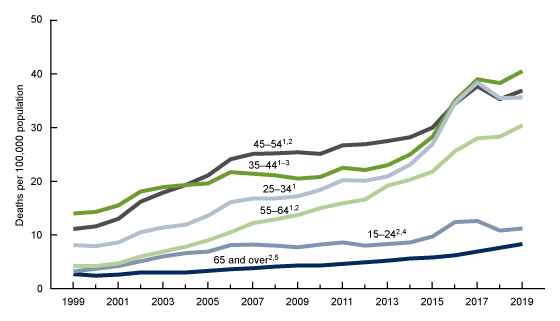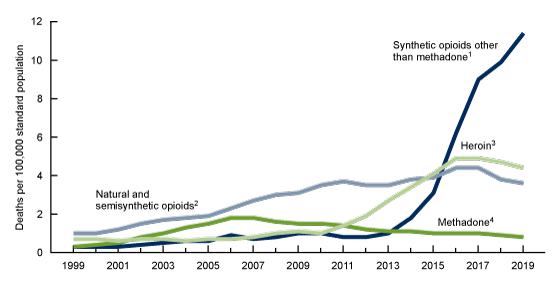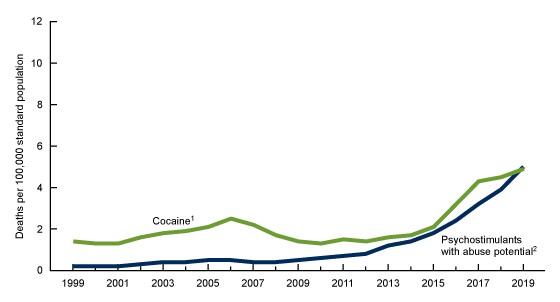Drug Overdose Deaths in the United States, 1999–2019
- Key findings
- In 2019, the age-adjusted rate of drug overdose deaths in the United States was higher than the rate in 2018.
- Among persons aged 15 and over, adults aged 35–44 had the highest rate of drug overdose deaths in 2019.
- Rates of drug overdose deaths involving heroin, natural and semisynthetic opioids, and methadone decreased between 2018 and 2019, while the rate of overdose deaths involving synthetic opioids other than methadone continued to increase.
- From 2012 through 2019, the age-adjusted rates of drug overdose deaths involving cocaine and psychostimulants with abuse potential continued their increases from previous years.
- Summary
- Definitions
- Data source and methods
- About the authors
- References
- Suggested citation
PDF Version (224 KB)
Key findings
Data from the National Vital Statistics System, Mortality
- The age-adjusted rate of drug overdose deaths in 2019 (21.6 per 100,000) was higher than in 2018 (20.7).
- In 2019, adults aged 35–44 had the highest rate of drug overdose deaths (40.5 per 100,000).
- The average annual increase in the rate of drug overdose deaths involving synthetic opioids other than methadone was lower from 2017 through 2019 (9% per year) than from 2013 through 2017 (75%).
- In 2019, the rates of drug overdose deaths involving heroin, natural and semisynthetic opioids, and methadone were lower than in 2018.
- From 2012 through 2019, the rate of drug overdose deaths involving cocaine increased more than 3-fold (from 1.4 to 4.9), while those involving psychostimulants with abuse potential increased more than 6-fold (from 0.8 to 5.0).
Deaths from drug overdose continue to be a public health burden in the United States (1–5). This report uses the most recent data from the National Vital Statistics System (NVSS) to update statistics on deaths from drug overdose in the United States, including information on trends from 1999 through 2019 by sex and age group, and by specific types of drugs involved (i.e., opioids and stimulants).
Keywords: opioids, fentanyl, heroin, cocaine, methamphetamine, National Vital Statistics System Mortality File
In 2019, the age-adjusted rate of drug overdose deaths in the United States was higher than the rate in 2018.
- In 2019, 70,630 drug overdose deaths occurred in the United States for an age-adjusted rate of 21.6 per 100,000 standard population (Figure 1).
- The age-adjusted rate of drug overdose deaths increased from 1999 through 2017, with different rates of change over time. The rate in 2018 (20.7) was significantly lower than the rate in 2017 (21.7). The rate in 2019 (21.6) was significantly higher than the rate in 2018 and similar to the rate in 2017.
- The rate for males was higher than for females throughout the entire period.
- For males, the rate increased from 8.2 in 1999 to 29.1 in 2017, decreased to 27.9 in 2018, and increased to 29.6 in 2019. The rate for males in 2019 was significantly higher than the rate in 2017 and 2018.
- For females, the rate increased from 3.9 in 1999 to 14.4 in 2017, then decreased to 13.6 in 2018 and 13.7 in 2019. The rate for females in 2019 was not significantly different from the rate in 2018, and was lower than the rate in 2017.
Figure 1. Age-adjusted drug overdose death rates, by sex: United States, 1999–2019

1Rates for males were significantly higher than rates for females for all years, p < 0.05.
NOTES: Significant increasing trend from 1999 through 2017, with different rates of change over time for all groups, p < 0.05. Drug overdose deaths are identified using the International Classification of Diseases, 10th Revision (ICD–10) underlying cause-of-death codes X40–X44, X60–X64, X85, and Y10–Y14. Age-adjusted death rates were calculated using the direct method and the 2000 U.S. standard population. The number of drug overdose deaths in 2019 was 70,630. Access data table for Figure 1.
SOURCE: National Center for Health Statistics, National Vital Statistics System, Mortality.
Among persons aged 15 and over, adults aged 35–44 had the highest rate of drug overdose deaths in 2019.
- The rate of drug overdose deaths increased from 1999 through 2019 for all groups aged 15 and over, although the patterns of increase varied by age group, with different rates of change over time (Figure 2).
- Among persons aged 15 and over, the rate in 2019 was highest for persons aged 35–44 (40.5 per 100,000).
- For all age groups except 25–34, the rate in 2019 was significantly higher than the rate in 2018.
Figure 2. Drug overdose death rates among those aged 15 and over, by selected age group: United States, 1999–2019

1Significant increasing trend from 1999 through 2017, with different rates of change over time, p < 0.05.
2Rate in 2019 was significantly higher than the rate in 2018, p < 0.05.
3Age group with the highest rate in 2019, p < 0.05.
4Significant increasing trend from 1999 through 2006 and from 2013 through 2017, with different rates of change over time, p < 0.05.
4Significant increasing trend from 1999 through 2019, with different rates of change over time, p < 0.05.
NOTES: Drug overdose deaths are identified using the International Classification of Diseases, 10th Revision (ICD–10) underlying cause-of-death codes X40–X44, X60–X64, X85, and Y10–Y14. Access data table for Figure 2.
SOURCE: National Center for Health Statistics, National Vital Statistics System, Mortality.
Rates of drug overdose deaths involving heroin, natural and semisynthetic opioids, and methadone decreased between 2018 and 2019, while the rate of overdose deaths involving synthetic opioids other than methadone continued to increase.
- The age-adjusted rate of drug overdose deaths involving synthetic opioids other than methadone, which include drugs such as fentanyl, fentanyl analogs, and tramadol, increased from 1.0 per 100,000 in 2013 to 11.4 in 2019. The average annual increase in the rate was lower from 2017 through 2019 (9% per year) than from 2013 through 2017 (75% per year) (Figure 3).
- The age-adjusted rate of drug overdose deaths involving heroin was stable from 1999 through 2005, then increased from 0.7 in 2005 to 4.9 in 2016 and 2017. From 2016 through 2019, the rate decreased from 4.9 to 4.4.
- The age-adjusted rate of drug overdose deaths involving natural and semisynthetic opioids, which include drugs such as oxycodone and hydrocodone, increased from 1.0 in 1999 to 3.7 in 2011, then increased again to 4.4 in 2016 and 2017. The rates in 2018 (3.8) and 2019 (3.6) were lower than the rate in 2017 (4.4).
- The rate of drug overdose deaths involving methadone increased from 0.3 in 1999 to 1.8 in 2006 and 2007. From 2006 through 2019, the rate decreased on average by 6% per year (from 1.8 to 0.8).
Figure 3. Age-adjusted rates of drug overdose deaths involving opioids, by type of opioid: United States, 1999–2019

1Significant increasing trend from 1999 through 2006 and 2013 through 2019, with different rates of change over time, p < 0.05.
2Significant increasing trend from 1999 through 2017, with different rates of change over time, p < 0.05.
3Significant increasing trend from 2005 to 2016, with different rates of change over time, then significant decreasing trend from 2016 through 2019, p < 0.05.
4Significant increasing trend from 1999 to 2006, with different rates of change over time, then significant decreasing trend from 2006 through 2019, p < 0.05.
NOTES: Drug overdose deaths are identified using the International Classification of Diseases, 10th Revision (ICD–10) underlying cause-of-death codes X40–X44, X60–X64, X85, and Y10–Y14. Drug overdose deaths involving selected drug categories are identified by specific multiple-cause-of-death codes: heroin, T40.1; natural and semisynthetic opioids, T40.2; methadone, T40.3; and synthetic opioids other than methadone, T40.4. Deaths involving more than one opioid category (e.g., a death involving both methadone and a natural or semisynthetic opioid) are counted in both categories. Natural and semisynthetic opioids include drugs such as morphine, oxycodone, and hydrocodone; and synthetic opioids other than methadone include drugs such as fentanyl, fentanyl analogs, and tramadol. The percentage of drug overdose deaths that identified the specific drugs involved varied by year, ranging from 75%–79% from 1999 through 2013 and increasing from 81% in 2014 to 94% in 2019. Access data table for Figure 3.
SOURCE: National Center for Health Statistics, National Vital Statistics System, Mortality.
From 2012 through 2019, the age-adjusted rates of drug overdose deaths involving cocaine and psychostimulants with abuse potential continued their increases from previous years.
- The age-adjusted rate of drug overdose deaths involving cocaine increased from 1.4 per 100,000 in 1999 to 2.5 in 2006, then decreased to 1.4 in 2012. From 2012 through 2019, the rate more than tripled from 1.4 in 2012 to 4.9 in 2019 (Figure 4).
- The age-adjusted rate of drug overdose deaths involving psychostimulants with abuse potential, which include drugs such as methamphetamine, amphetamine, and methylphenidate, increased from 0.2 in 1999 to 0.5 in 2005, remained stable from 2005 through 2008, then increased from 0.4 in 2008 to 5.0 in 2019. From 2012 through 2019, the rate increased on average by 29% per year.
Figure 4. Age-adjusted rates of drug overdose deaths involving stimulants, by type of stimulant: United States, 1999–2019

1Significant increasing trend from 1999 to 2006, decreasing trend from 2006 to 2012, and increasing trend from 2012 through 2019, with different rates of change over time, p < 0.05.
2Significant increasing trend from 1999 through 2005 and 2008 through 2019, with different rates of change over time, p < 0.05.
NOTES: Drug overdose deaths are identified using the International Classification of Diseases, 10th Revision (ICD–10) underlying cause-of-death codes X40–X44, X60–X64, X85, and Y10–Y14. Drug overdose deaths involving selected drug categories are identified by specific multiple-cause-of-death codes: cocaine, T40.5; and psychostimulants, T43.6. Psychostimulants with abuse potential include drugs such as methamphetamine, amphetamine, and methylphenidate. Deaths may involve more than one drug. The percentage of drug overdose deaths that identified the specific drugs involved varied by year, ranging from 75%–79% from 1999 through 2013 and increasing from 81% in 2014 to 94% in 2019. Access data table for Figure 4.
SOURCE: National Center for Health Statistics, National Vital Statistics System, Mortality.
Summary
Although the rate of drug overdose deaths was significantly lower in 2018 than in 2017 (20.7 and 21.7 per 100,000, respectively), the rate in 2019 (21.6) was higher than the 2018 rate and similar to the 2017 rate. From 2018 through 2019, rates for males increased (from 27.9 to 29.6), while rates for females showed no significant change (13.6 in 2018 and 13.7 in 2019). From 1999 through 2019, rates increased for all groups aged 15 and over, although the patterns of increase varied by age group, with different rates of change over time. In 2019, the rate was highest for adults aged 35–44 at 40.5 per 100,000.
The rate of drug overdose deaths involving synthetic opioids other than methadone (drugs such as fentanyl, fentanyl analogs, and tramadol) continued to increase; however, the average rate of increase has slowed in the most recent years, from an average annual increase of 75% per year from 2013 through 2017 to 9% per year from 2017 through 2019. The rates of drug overdose deaths involving heroin, natural and semisynthetic opioids, and methadone were lower in 2019 than in 2018 (from 4.7 in 2018 to 4.4 in 2019 for heroin, from 3.8 in 2018 to 3.6 in 2019 for natural and semisynthetic opioids, and from 0.9 in 2018 to 0.8 in 2019 for methadone). In contrast, the rates of drug overdose deaths involving cocaine and psychostimulants with abuse potential (drugs such as methamphetamine) were higher in 2019 than in 2018 (from 4.5 in 2018 to 4.9 in 2019 for cocaine, and from 3.9 in 2018 to 5.0 in 2019 for psychostimulants with abuse potential).
Definitions
Drug poisoning (overdose) deaths: Includes deaths resulting from unintentional or intentional overdose of a drug, being given the wrong drug, taking a drug in error, or taking a drug inadvertently.
Natural and semisynthetic opioids: Includes drugs such as morphine, codeine, hydrocodone, and oxycodone.
Synthetic opioids other than methadone: Includes drugs such as fentanyl, fentanyl analogs, and tramadol.
Psychostimulants with abuse potential: Includes drugs such as methamphetamine, amphetamine, and methylphenidate.
Data source and methods
Estimates are based on the NVSS multiple-cause-of-death mortality files (6). Drug poisoning (overdose) deaths were defined as having an International Classification of Diseases, 10th Revision (ICD–10) underlying cause-of-death code of X40–X44 (unintentional), X60–X64 (suicide), X85 (homicide), or Y10–Y14 (undetermined intent). Of the drug overdose deaths in 2019, 88.0% were unintentional, 6.8% were suicides, 5.0% were of undetermined intent, and less than 1.0% were homicides. The type of drug(s) involved are indicated by ICD–10 multiple-cause-of-death codes: heroin, T40.1; natural and semisynthetic opioids, T40.2; methadone, T40.3; synthetic opioids other than methadone, T40.4; cocaine, T40.5; and psychostimulants with abuse potential, T43.6.
Age-adjusted death rates were calculated using the direct method and adjusted to the 2000 standard population (7). Trends in age-adjusted death rates were evaluated using the Joinpoint Regression Program (Version 4.8.0.1) (8). Joinpoint software fitted weighted least-squares regression models to the rates on the log transform scale. Analyses were set to allow a maximum of three joinpoints across the period, a minimum of three observed time points from any given joinpoint to either end of the data, and a minimum of four observed time points between any two joinpoints. The permutation tests for model (number of joinpoints) significance were set at an overall alpha level of 0.05 (9). Pairwise comparisons of rates (e.g., age-adjusted rates for males compared with females and year-to-year comparisons) were conducted using the z test with an alpha level of 0.05 (7).
Several factors related to death investigation and reporting may affect measurement of death rates involving specific drugs. At autopsy, the substances tested for and the circumstances under which the toxicology tests are performed vary by jurisdiction. This variability is more likely to affect substance-specific death rates than the overall drug overdose death rate. The percentage of drug overdose deaths that identified the specific drugs involved varied by year, ranging from 75%–79% from 1999 through 2013 and increasing from 81% in 2014 to 94% in 2019.
Additionally, drug overdose deaths may involve multiple drugs; therefore, a death might be included in more than one category when describing the rate of drug overdose deaths involving specific drugs. For example, a death that involved both fentanyl and cocaine would be included in both the rate of drug overdose deaths involving synthetic opioids other than methadone and the rate of drug overdose deaths involving cocaine.
About the authors
Holly Hedegaard is with the National Center for Health Statistics (NCHS), Division of Analysis and Epidemiology. Arialdi M. Miniño and Margaret Warner are with NCHS, Division of Vital Statistics.
References
- Hedegaard H, Miniño AM, Warner M. Drug overdose deaths in the United States, 1999–2018. NCHS Data Brief, no 356. Hyattsville, MD: National Center for Health Statistics. 2020.
- Ahmad FB, Rossen LM, Spencer MR, Warner M, Sutton P. Provisional drug overdose death counts. Vital Statistics Rapid Release. Hyattsville, MD: National Center for Health Statistics. 2020.
- Hedegaard H, Spencer MR, Garnett MF. Increase in drug overdose deaths involving cocaine: United States, 2009–2018. NCHS Data Brief, no 384. Hyattsville, MD: National Center for Health Statistics. 2020.
- O’Donnell J, Gladden RM, Mattson CL, Hunter CT, Davis NL. Vital signs: Characteristics of drug overdose deaths involving opioids and stimulants—24 states and the District of Columbia, January–June 2019. MMWR Morb Mortal Wkly Rep 69(35):1189–97. 2020.
- Wilson N, Kariisa M, Seth P, Smith H IV, Davis NL. Drug and opioid-involved overdose deaths—United States, 2017–2018. MMWR Morb Mortal Wkly Rep 69(11):290–7. 2020
- National Center for Health Statistics. Public-use data files: Mortality multiple cause files. 2019.
- Kochanek KD, Murphy SL, Xu JQ, Arias E. Deaths: Final data for 2017. National Vital Statistics Reports; vol 68 no 9. Hyattsville, MD: National Center for Health Statistics. 2019.
- National Cancer Institute. Joinpoint Regression Program (Version 4.8.0.1) [computer software]. 2019.
- Ingram DD, Malec DJ, Makuc DM, Kruszon-Moran D, Gindi RM, Albert M, et al. National Center for Health Statistics guidelines for analysis of trends. National Center for Health Statistics. Vital Health Stat 2(179). 2018.
Suggested citation
Hedegaard H, Miniño AM, Warner M. Drug overdose deaths in the United States, 1999–2019. NCHS Data Brief, no 394. Hyattsville, MD: National Center for Health Statistics. 2020.
Copyright information
All material appearing in this report is in the public domain and may be reproduced or copied without permission; citation as to source, however, is appreciated.
National Center for Health Statistics
Brian C. Moyer, Ph.D., Director
Amy M. Branum, Ph.D., Acting Associate Director for Science
Division of Analysis and Epidemiology
Irma E. Arispe, Ph.D., Director
Kevin C. Heslin, Ph.D., Associate Director for Science
Division of Vital Statistics
Steven Schwartz, Ph.D., Director
Isabelle Horon, Dr.P.H., Acting Associate Director for Science